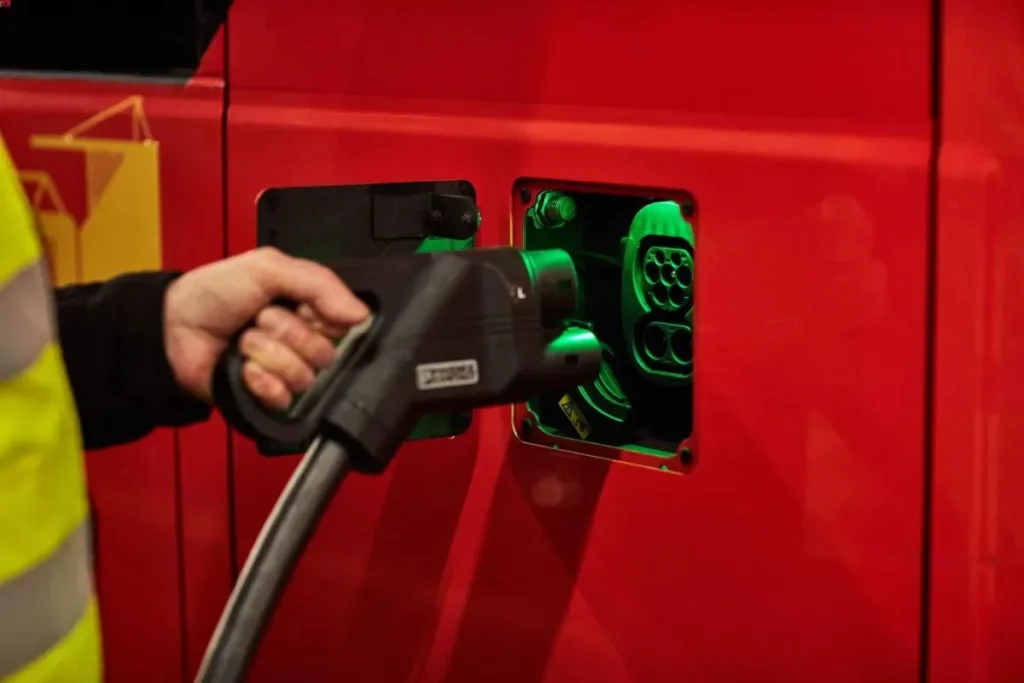Automation and digitization are essential. Unfortunately, most companies are still unaware of this. “Even if you look at the largest, Fortune 500 companies, I would say that only 80% of them know that transformation is essential, the rest 20% is just realizing it now”- estimates Nabil Malouli, DHL Vice President. – But that’s not all. Of this 80 %, only about 30 % focuses on actions – they change the style of work, introduce new technologies and develop them – he adds, explaining how such a transformation looks and how much time it takes for a company to notice its benefits.
Trans.INFO: In the next six years you plan to spend as much as 2 billion euros on digitization. What exactly do you want to spend this money on?
Nabil Malouli, Vice President DHL : First of all, we will invest in automation and robotics, but this is only one area. As a large organization, we operate in various fields, from warehouse operations to the last-mile service. Where we invest this money, will depend on the entire digitization plan, which will apply to both the technologies we have developed ourselves and those that we develop together with partners.
Let’s talk about this cooperation with partners. You are a 3PL operator, and this means that your role as a supplier requires the selection of means of transport and executive supervision. On the partners’ side, cooperation means the construction of the supply chain itself. How do these partnerships work in practice, like in the field of automation and robotics you mentioned before?
I think that building a supply chain usually requires working together. Especially when we talk about large companies that typically work closely with us to achieve the optimal effect. Many customers come to us, experts, to consult, especially regarding specific services like forwarding services for example. However, the entire supply chain has many parts that we can help shape. The reason why such a reconstruction is more necessary today is mainly due to the development of e-commerce and the emergence of new technologies.
Even 40 years ago, everything was static. Changes did not occur so quickly, so many companies were able to handle the transformation themselves. And they did it successfully. Today, however, everything is happening very quickly. New technologies are emerging, integrations, new players on the market, and all this makes asking for help necessary.
Therefore, companies, best in their field, seek support from operators, and logistics companies, because the biggest advantage of working with such helpers is that they are in contact with new technologies every day and are able to assess them. No wonder then that even the largest and most successful companies are asking for help.
Does this mean that all your partners are open to new technologies? Studies show that up to 95 percent of companies are still unaware of the need for automation and digitization.
I think it’s an interesting issue. In my opinion, we are talking about two things: understanding and trying. Over the past three years, many companies have realized the importance of change. Still, many of them have not started introducing it. Our research also shows that e.g. the level of entering e-commerce is very low.
Even if you look at the largest, Fortune 500 companies, I would say that 80 % of them are aware of the fact that transformation is important, and only 20% of them have achieved this. However, this is not all. Of this 80 % only about 30 % are focusing on taking specific actions – to change the style of work, introduce new technologies and develop them ( some experts estimate that in 15 years up to 43 percent of market leaders will fail – editor’s note ).
I came across a study in which almost half of the respondents said that it is difficult to estimate the benefits of automation and digitization because it is simply too early for that. Maybe companies are simply afraid of such experiments? They probably find them expensive.
I think there are many reasons. Very often people look into the past to determine their future. Today, however, this is not a good strategy, even if it has been successful for 30 years, because, as I said, we live in exceptional times.
So, the first reason may be the way of thinking. Even if people are aware of the fact that change is important, they still do not implement it. And the truth is that companies that start operating today quickly will have a better chance of survival. A good example is the US retail industry. It’s not just about the expansion of Amazon, but about changing the behaviour of consumers who no longer want to go to stores, do not want to look for the product on the shelf, but they want a rich shopping experience.
The second reason is the investment calculation. Companies look at new technologies and estimate that their introduction will cost a lot, e.g. $ 50 million. Meanwhile, they have been able to operate on investments of USD 10 million so far. No automation, no modern technologies.
This is a mistake. Today, in many cases, investing in such solutions with a view to logistics is a key turning point. Logistics used to be a department to support the business. Today it is becoming something that can give you an advantage – this advantage is the reason why someone is reaching out for a product of a particular company, interested in how quickly it will get, how much it will cost …
So I think that in the next five years, those who don’t realize this will have problems. Experts even argue that in ten years up to 50% of the Fortune 500 companies may disappear because of this.
In that case, how does automation look at your client’s? Given what we have said so far, it seems to me that it is necessary for these companies to be able to cooperate with you and be compatible with you.
In fact, it’s not about compatibility at all. Rather about business needs. I will explain this with an example, although without giving specific names. We have a client from the retail industry, a leading brand in the world who reports to us and says that they want to develop their e-commerce business. It focuses on next-day delivery or even same-day delivery, and in addition, it has a very wide SKU range (storage unit, relating to goods management – editor’s note).
And what is interesting, in this case, as in the case of many other companies with whom we cooperate, the conversation does not concern primarily costs, but services. Because if you have a big company that exports 100,000 products daily from the warehouse, and at the same time the return ratio is at the level of 30-40 %, it means that you can no longer rely on manual work.
We can help them to manage all orders placed by a certain time in the afternoon being sent the same day to consumers in different parts of Europe. But, as I say, we can no longer rely on manual work.
So we are introducing this client to the technology that they will need to start using. We recommend the best type of transport system, sorter, WMS (Warehouse Management System). Listening to what the client wants to achieve, we suggest what to invest in. Sometimes it may turn out that not everything has to be sent on the same day because some orders can be processed within 2-3 days. Then, the investments are correspondingly lower – not 50 million dollars but e.g. 20 – 10 million.
However, it is important for the company to realize the importance of e-commerce support. Today, when the customer presses the “place order” button, all tasks in the entire supply chain must happen very quickly. For one order it’s easy. But think of big brands like ASOS or Zalando, which send tens of thousands of products daily. In their case, investing in new technologies and automation is a must.
How much time does it take to implement such a “change” for the client from turning to the 3PL operator to automation?
Usually between 12 and 18 months. We usually meet with the board to find out what they want to achieve. Then we gather groups of experts – technological, operational, commercial – on both sides. We create a work program and then start it.
What are the costs?
It depends. Each case must be approached individually. We have partners with whom we have very close relations, so we sometimes share the costs of such investments. There are also situations when we invest as well as when the client does it. Most often, however, we share costs by introducing new solutions together.
So please tell me about one example of such cooperation.
I will tell you about the one I worked for in the USA. We have a customer whose return rate was not great – about 10 %. The SKU range (assortment items – note) was very large, at 100,000. pieces.
This is a brand that has worked in a certain way for 40 years. It started operating in the e-commerce segment, however, trying to use the current business model. The company came to us saying that it had just finished the holiday season but failed to reach the assumed level of services in e-commerce.
We decided that this business must be managed according to completely different principles. We created a joint team in which we were thinking about a solution. What a warehouse should look like, how it should be automated, what technologies to use, what kind of employees need to be recruited and how. When it came to technologies, we talked about the selection of a number of solutions – from WMS and WES (Warehouse Execution System), through integration with various other systems, to integration solutions related to the shipment of goods.
It takes about 4 months to create such a model of cooperation. A lot of time, but also requires a lot of work. We are talking about a workplace where more than a thousand people operate. Only when we reach agreement on all issues do we begin to implement these solutions – we order systems related to facility mechanization, we build an IT platform. It usually takes six to 12 months to build such an infrastructure in a warehouse.
In the case about which I’m talking about, you had to put up a warehouse with an area of over 700 thousand square feet (over 65,000 sq m – editor’s note) and with a very high level of automation. It took us 18 months. In the beginning, the building was partly operated manually, only later was it fully automated. This is a common practice in situations where there is not enough time for implementation.
However, even when everything is already automated, we still work with the partner to optimize solutions, to introduce mobile technology. Such work never ends, it is very important to realize this. Because even the highest-class technology currently will probably not be the best in three years.
How much time does it take for the company to notice the benefits of such automation?
It depends on what automation we’re talking about. If it is about permanent robots and fixed robots, then from 2 to 6 years. So much time must pass for the return on investment to occur. However, if you are talking about mobile technology and mobile robots, it’s much faster, actually right away, because companies are increasingly not buying such solutions, but leasing them. We are currently observing greater interest in this second type of investment because mobile solutions can be re-implemented and used in various businesses.
On the other hand, permanent solutions work well in companies with a far-reaching development perspective, and besides, they know that their clients’ profile and activities will not change. Enterprises selling, for example, jeans for brands such as Diesel or Levis may have such a perspective, even for a decade. So perhaps for them automating in this way may be optimal.
It is different for companies that operate like marketplaces because they offer so many different categories of products. Today, e.g. in the consumer electronics category, but in five years they can deal with car parts, which is something completely different. These companies want to have more flexibility in investing, so they will focus on mobile automation.
One last thing, a bit of a summary. What future do you see for companies that will not want to automate and digitize?
I don’t think they will completely disappear. However, I think that it will be very difficult for them to remain competitive, because today, to provide services in an effective way, you need to have support in technology. One thing is a whole bunch of data that you gain thanks to access to technology and which streamlines business processes. The other is a change in the development of companies. Today, if a business is working well, the company looks at it, the scale and technologies it uses, and states that it can use it to create another business. Uber can be a good example of this. They looked at the platform that was used to search for the transportation of people and noticed that the same technology could be useful in the case of a restaurant business as well as cargo transport.
Both independent companies and those that work with partners will go in this direction. The latter can say – we have a scale, you, partner, a technology. So we can start cooperating even more closely. I think there will be more and more such relationships.
Author: Dorota Ziemkowska, cooperation: Dorota Piotrowska-Pełka
The conversation took place during the HyperLOG conference.
Photos: Trans.INFO




